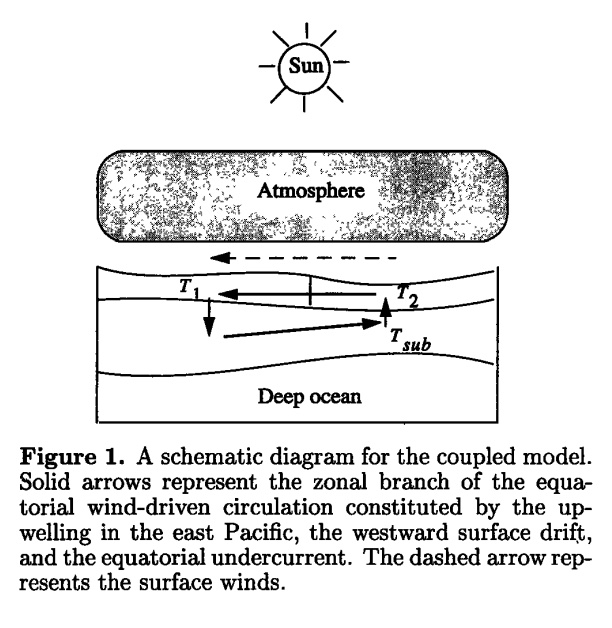A Diabatic and Nonlinear Origin of El Niño
There exist two equilibrium states for the tropical Pacific--one is zonally symmetric (or nearly so) with the warm-pool extending all the way to the eastern Pacific, and the other is strongly zonally asymmetric with the warm-pool confined to the western half of the tropical Pacific. ENSO results from the fact that under the current radiative heating, both states are unstable, resulting in the apparent "wandering" behavior in between these two states as seen in the observations. (In other words, the coupled tropical Pacific is a bi-unstable system under strong radiative heating). This theory concerning the origin of El Nino was first proposed by Sun (1997) using a box model for the coupled tropical Pacific ocean-atmosphere system. Below is a schematic of that model (Fig. 1 of Sun 1997).
- Sun, D.-Z., 1997: El Niño: a coupled response to radiative heating? Geophys. Res. Lett., 24, 2031-2034.
A surprising aspect of the Sun model of El Nino is that it simulates the ENSO asymmetry, an observed aspect of this phenomenon and has been difficult for the previous theories, such as the delayed oscillator and the recharge and discharge oscillator to account for. Related to its success in simulating ENSO asymmetry, the ENSO in the model is also featured with the existence of extreme El Nino events and more generally the existence of a rich spectrum for the magnitudes of El Nino events.
- Liang, J., X.-Q. Yang, and D.-Z. Sun, 2017: Factors Determining the Asymmetry of ENSO. J. Climate, 30, 6097-6106. DOI: 10.1175/JCLI-D-16-0923.1
The Sun model also provides a pedagogic case to show that the climatology is not an equilibrium state of the system, rather, a strong function of the amplitudes of ENSO.
- Liang, J., X.-Q. Yang, and D.-Z. Sun, 2012: The effect of ENSO events on the Tropical Pacific Mean Climate: Insights from an Analytical Model. J. Climate, 25, 7590-7606.
But most importantly, this diabatic and nonlinear view has shed light onto the central role of the intensity of heating. It has provided a mathematical theory to explain why the coupled system has to "relax" once in a while in the process of moving heat downward (and thereby poleward). In short, the answer from this theory to this question is that the "workload" is too heavy. The theory also shows that both a state characterized by a permanent El Nino and a state that is characterized by a permanent La Nina are both solutions of the system, providing an opportunity to account for such behaviors that have been suggested in the past climates.
- Hua, L., D.-Z. Sun, and Y. Yu, 2019: Why Do We Have El Niño: Quantifying A Diabatic and Nonlinear Perspective Using Observations. Climate Dynamics, 52(11), 6705-6717. DOI: 10.1007/s00382-018-4541-4
The central role of heating is consistent with findings from a series of observational and modeling studies.
- Sun, D.-Z. and K.E. Trenberth, 1998: Coordinated heat removal from the equatorial Pacific during the 1986-87 El Niño. Geophys. Res. Lett., 25, 2659-2662
- Sun, D.-Z., 2003: A Possible Effect of An Increase in the Warm-pool SST on the Magnitude of El Niño Warming. J. Climate, 16, 185-205
- Sun, D.-Z. and T. Zhang, 2006: A Regulatory Effect of ENSO on the Time-Mean Thermal Stratification of the Equatorial Upper Ocean. Geophys. Res. Lett., Vol. 33, L07710, doi:10.1029/2005GL025296.
- Sun, D.-Z., T. Zhang, Y. Sun, and Y. Yu, 2014: Rectification of El Nino-Southern Oscillation into Climate Anomalies of Decadal and Longer Time-scales: Results from Forced Ocean GCM Experiments. J. Climate, 27, 2545-2561.
